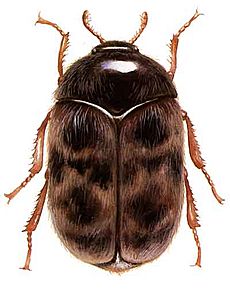Khapra beetle facts for kids
Quick facts for kids Khapra beetle |
|
|---|---|
 |
|
| Adult Khapra beetle | |
| Scientific classification | |
| Kingdom: | |
| Phylum: | |
| Class: | |
| Order: | |
| Family: | |
| Genus: |
Trogoderma
|
| Species: |
T. granarium
|
| Binomial name | |
| Trogoderma granarium Everts, 1898
|
|
The Khapra beetle (Trogoderma granarium) is a tiny insect that causes big problems. It originally came from South Asia but has spread to many parts of the world. This beetle is known as one of the most damaging pests for stored grain and seeds. In fact, it's considered one of the top 100 worst invasive species globally because of the harm it causes.
Infestations of the Khapra beetle are very hard to control. This is because the insect can survive for a long time without food. It also prefers dry places and food with low moisture. Plus, it can resist many insecticides, which are chemicals used to kill insects. Because of these challenges, some countries, like the U.S., have strict rules. There is a federal quarantine that limits importing rice from countries where the beetle is known to live.
Contents
What is the Khapra Beetle?
The Khapra beetle is a very small insect, usually less than 3 millimeters long. That's about the size of a pinhead! Adult beetles are reddish-brown to black. Their bodies are covered in fine hairs. The larvae, which are the young beetles, are yellowish-brown and also hairy. They are the ones that cause most of the damage.
These beetles are a big threat to stored products. They love to eat grains like wheat, rice, and corn. They also feed on seeds, nuts, and dried fruits. When they infest food, they don't just eat it. They also leave behind their skin, hairs, and waste. This makes the food unsafe and unusable.
Where Do Khapra Beetles Come From?
The Khapra beetle first appeared in South Asia, especially in India. From there, it has spread to many other parts of the world. It often travels hidden in shipments of grain or other food products. This makes it easy for the beetle to move from one country to another. Once it arrives in a new place, it can quickly start new infestations.
What Makes Them So Tough?
Khapra beetles are very difficult to get rid of for several reasons:
- Survival Skills: They can live for a long time without food. This means they can survive in empty storage areas.
- Dry Conditions: They prefer dry, warm places. Many storage facilities for grain are perfect for them.
- Pesticide Resistance: Over time, they have become resistant to many common insecticides. This makes chemical treatments less effective.
- Hidden Life: The larvae can hide in tiny cracks and crevices. This makes them hard to find and reach.
Life Cycle of the Khapra Beetle
The Khapra beetle goes through a complete metamorphosis during its life cycle. This means it has four stages: egg, larva, pupa, and adult.
Eggs
Female Khapra beetles lay tiny, oval-shaped eggs. They usually lay them directly on or near food sources. The eggs are very small and hard to see.
Larvae
After a few days, the eggs hatch into larvae. This is the most damaging stage. The larvae are worm-like and covered in bristly hairs. They feed constantly on stored grains and other products. They grow by shedding their skin several times, a process called molting. If food is scarce, the larvae can go into a resting state called diapause. They can stay in this state for months or even years, waiting for better conditions.
Pupae
Once the larvae are fully grown, they change into pupae. The pupa stage is a resting stage where the beetle transforms. They don't eat during this time.
Adults
Finally, the pupae turn into adult beetles. Adult Khapra beetles live for a short time, usually only a few weeks. Their main job is to mate and lay eggs, starting the cycle all over again. They do not feed much, if at all, during their adult stage.
How Do We Stop Them?
Because Khapra beetles are so destructive, countries work hard to prevent their spread.
- Quarantine Rules: Many countries have strict quarantine rules. This means they inspect imported goods very carefully. If a shipment is found to have Khapra beetles, it might be sent back or destroyed.
- Inspection: Regular inspections of storage facilities are important. Early detection helps prevent large infestations.
- Sanitation: Keeping storage areas clean and free of spilled grains helps. Removing any food sources makes it harder for beetles to survive.
- Fumigation: In some cases, special gases called fumigants are used to kill beetles. This is often done in sealed areas like ships or warehouses.
The fight against the Khapra beetle is ongoing. It requires careful monitoring and quick action to protect our food supplies.
See also
 In Spanish: Trogoderma granarium para niños
In Spanish: Trogoderma granarium para niños

